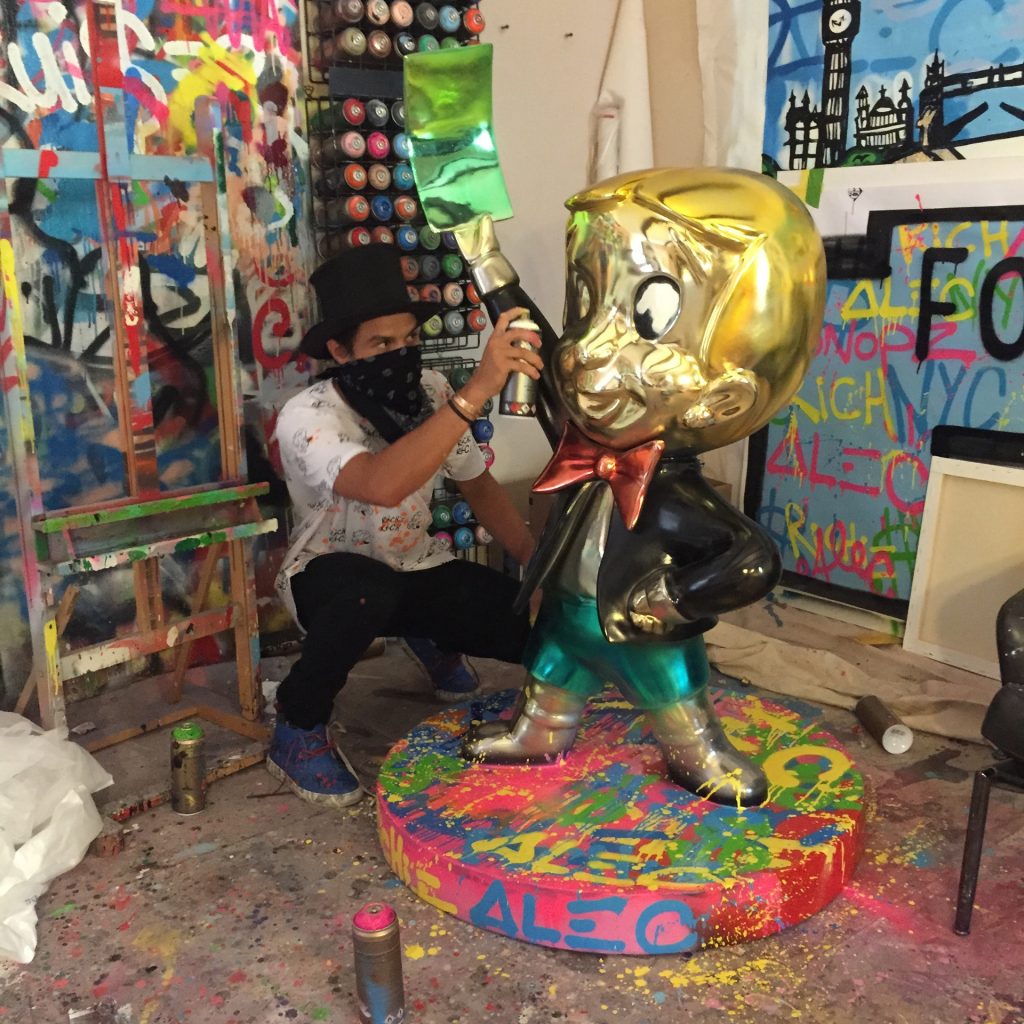CELEBRITIES ACROSS GENRES AND COASTS ARE EATING UP THE GRAFFITI GRAVITAS OF THIS CULTURE-SHAPING, FAMOUSLY ELUSIVE STREET ARTIST, FROM SETH ROGAN TO SNOOP DOGG
BY DAN SALAMONE
The art of Alec Monopoly is the spirit of mischievous play set to canvas. Born Alec Andon in New York about 38 years ago (even a determined internet search reveals conflicting DOBs), Alec is a street artist and DJ whose War holes queue play with cultural signifiers has captured the attention of a wealth of mega-celebrities, from Snoop Dogg, Seth Rogan, and Miley Cyrus to Justin Bieber, Robin Ficke, and Adrien Brody.
Like Warhol or Banksy, Alec has famously taken the Mr. Monopoly icon (yes, from the same game that sponsored board throwing flights in your childhood) for his own wily purposes. The enigmatic artist-plus-entertainer has built a celebrated body of work around the idea of rebellion through play, often taking on the very capitalism precepts that modern Western culture is largely built upon, for better or (more often) worse. Wealth and power are ideas often found in the crosshairs of his ironic meta textual work, beginning with his choice of adopting the board game icon (named Rich Uncle Moneybags) for himself and putting it to his own cheeky post-modern purposes.

Even the biography of the man himself has proven to be slippery and elusive. Depending on which web expert you ask, he is either a child of Los Angeles, born in 1979, or (as is more commonly suggested) he was born in New York in 1986. One imagines that his “pranksy” nature finds this confusion delightful. If he was born in ‘86, he’s roughly a mid-gen Millennial. Or if he was born in 1979, he’s a just-got-in-under-the-wire Gen Xer. is dichotomy actually makes sense, in its nonsensical way. Within his artwork, the finance-forward, tech-savvy, status-conscious, hyper-creative Millennial bangs up against the status-denying, institution-mocking, sarcastic-to-the-point-of-fatalism Gen Xer.
e idea of being able to shift back and forth between personae is all very much part of what makes Alec’s art, and the artist himself, so stimulating. The big black top hat, black T-shirt, and bling, silly as they may seem, are all part of his costume, allowing him to effectively give a vessel to his ideas about art and commerce, and COVID provided a nice mask to don the look with extra anonymity. He’s spoken about how important this has been in allowing him to be both private and public-facing. As he told the magazine TodayOnline.com in 2022: “When I’m painting graffiti murals in the studio, I’m moving a million miles a minute. I’m working on everything and running around. I’m always moving…Socially, it’s great, too, because I can take off the mask and the hat, and I can live a normal life.”
Looking at his work, it’s easy to see how the day-glo-explosions of instantly recognizable cartoon (and cartoonish) icons would appeal to both droll art school ironists and exactly the kind of monied philistines the former camp would make fun of. There’s Mr. Monopoly carrying the familiar dollar sign bag that as kids we assumed all grown-ups possessed. There’s Richie Rich spinning a globe with “The World Is Yours” emblazed on it, and Scrooge McDuck with dollar signs in his eyes, greedily grinning with a bag bursting with cash in each hand. It’s provocative and comforting in equal measure. So, which camp is the art of Alec Monopoly for, exactly? The sly goodness of the persona and impish take on his subjects suggests it’s definitely for the wry exhibition snobs, but you don’t get five to six figures for a single piece of artwork just appealing to that crowd. (Artlife estimates the value of his original pieces to be between $25,000 and $125,000.) Ultimately, the art of Alec Monopoly isn’t exactly for either crowd. It’s for the artist himself, an artist with an eye for change.
Alec Monopoly


